We’ve all been there—you wake up late, glance at your hair in the mirror, and realize it’s not exactly fresh-wash ready, but you have an important meeting in an hour.
The good news is that greasy hair doesn’t have to derail your professional appearance or confidence at work.
In fact, oily hair can actually work to your advantage when styled correctly, offering texture, hold, and sleekness that freshly washed hair sometimes lacks.
This comprehensive guide on 27 Professional Greasy Hair Hairstyles for Work will transform the way you think about second-day (or third-day) hair, proving that you can look polished, put-together, and entirely professional even when your hair isn’t at its cleanest.
Whether you have long, medium, or short hair, straight or curly textures, you’ll discover practical, stylish solutions that not only disguise greasiness but actually use it as a styling tool.
From elegant updos and sophisticated braids to sleek ponytails and textured buns, each hairstyle is designed to help you walk into the office with confidence, knowing you look your absolute best regardless of your last wash day.
Contents
- 1 1. The Sleek Low Bun
- 2 2. The Classic High Ponytail
- 3 3. The French Twist
- 4 4. The Side-Swept Low Ponytail
- 5 5. The Braided Crown
- 6 6. The Twisted Half-Up Style
- 7 7. The Low Chignon
- 8 8. The Slicked-Back Style
- 9 9. The Messy Top Knot
- 10 10. The Side Braid
- 11 11. The Double Dutch Braids
- 12 12. The Wrapped Ponytail
- 13 13. The Vintage Victory Rolls
- 14 14. The Rope Braid Ponytail
- 15 15. The Low Side Bun
- 16 16. The Half-Up Braid
- 17 17. The Twisted Low Bun
- 18 18. The Braided Headband Style
- 19 19. The Bubble Ponytail
- 20 20. The Faux Hawk Updo
- 21 21. The Pulled-Through Braid
- 22 22. The Pinned-Back Sides
- 23 23. The Low Ponytail with Center Part
- 24 24. The Knotted Bun
- 25 25. The Twisted Side Updo
- 26 26. The Double Twisted Bun
- 27 27. The Rolled Chignon
- 28 Essential Products for Styling Greasy Hair Professionally
- 29 Tips for Maintaining Professional Hairstyles Throughout the Workday
- 30 Adapting Styles for Different Professional Environments
- 31 Understanding Hair Health While Working with Greasy Hair
- 32 Conclusion
1. The Sleek Low Bun

The sleek low bun is a timeless professional hairstyle that actually benefits from hair’s natural oils, creating a polished, sophisticated look that works perfectly in corporate environments.
This style takes advantage of greasy hair’s ability to stay smooth and controlled, eliminating flyaways that often plague freshly washed hair.
How to Create This Style:
- Brush your hair straight back from your face, allowing the natural oils to smooth down any frizz or texture.
- Gather all your hair at the nape of your neck, positioning it either at the center or slightly to one side depending on your preference.
- Twist the hair length around itself to form a coil, then wrap this coil into a circular shape at the base of your neck.
- Secure the bun firmly with bobby pins, inserting them in an X-pattern for maximum hold throughout your workday.
- Apply a small amount of hair gel or smoothing serum to your hairline and any areas where flyaways appear.
- Finish with a light mist of hairspray to lock everything in place without adding stiffness.
Why It Works for Greasy Hair:
The natural oils in unwashed hair provide the perfect amount of weight and texture to keep this bun sleek and secure without requiring excessive product.
2. The Classic High Ponytail

The classic high ponytail is a powerful, professional statement that exudes confidence and keeps hair completely off your face during busy workdays.
Greasy hair actually helps this style maintain its sleekness and prevents the ponytail from slipping down throughout the day.
Step-by-Step Instructions:
- Flip your head upside down and brush all your hair toward the crown of your head to gather it at the highest point.
- Stand upright and smooth any bumps or irregularities with your hands or a fine-toothed comb.
- Secure the ponytail tightly with a strong elastic band, wrapping it multiple times to ensure it won’t loosen.
- Take a small section of hair from the underside of the ponytail and wrap it around the elastic to conceal it.
- Pin the wrapped section underneath the ponytail base with a bobby pin for a refined finish.
- Gently tug on the crown area to add slight volume if your hair appears too flat against your scalp.
Professional Benefits:
This hairstyle keeps your face completely visible, which is essential for presentations, client meetings, and video conferences where engagement is key.
3. The French Twist
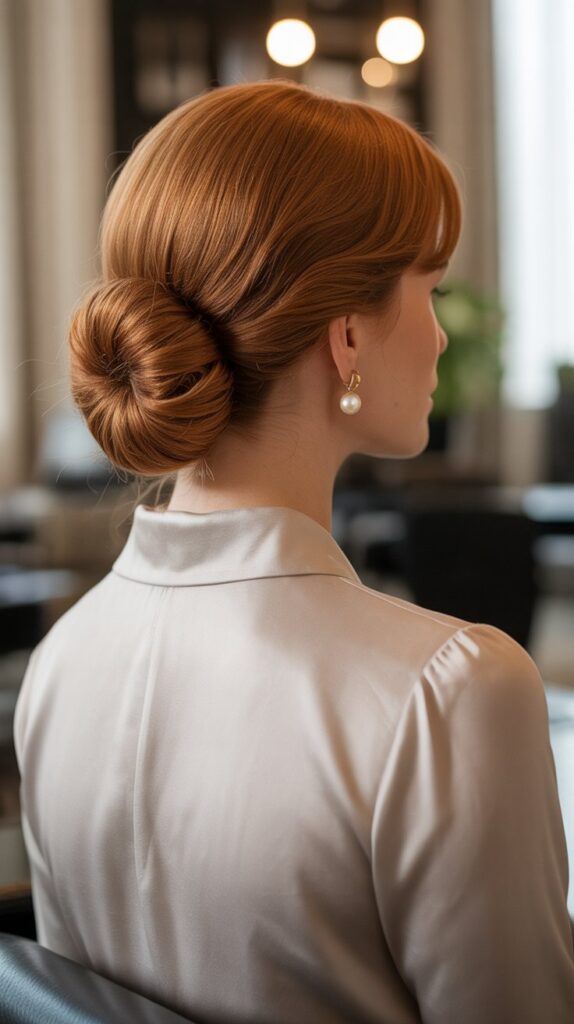
The French twist represents ultimate sophistication and elegance in professional hairstyling, transforming greasy hair into a refined updo that looks intentionally styled and expensive.
This classic style has been a boardroom staple for decades because it projects authority and polish.
Creating the Perfect French Twist:
- Brush your hair to one side of your head, gathering all the length toward either the left or right.
- Hold the gathered hair firmly with one hand while twisting it upward and inward toward the center back of your head.
- Continue twisting until the hair naturally folds into a vertical roll against your scalp.
- Tuck the ends of your hair into the twist, creating a seamless finish without any loose pieces hanging out.
- Secure the twist with bobby pins inserted vertically along the seam where the twist meets your head.
- Use additional pins horizontally at the top and bottom of the twist for extra security during long workdays.
Styling Enhancement:
The natural oils in greasy hair make it much easier to manipulate the hair into the twist and keep it there without pieces slipping out.
4. The Side-Swept Low Ponytail

The side-swept low ponytail offers an asymmetrical, modern take on traditional professional hairstyles while strategically using greasy hair’s texture to create interest and dimension.
This style appears effortless yet intentional, perfect for creative professional environments.
Application Method:
- Create a deep side part on whichever side you prefer, using the end of a comb for precision.
- Sweep all your hair over one shoulder, gathering it at the side of your neck rather than the center back.
- Secure with an elastic band, positioning the ponytail so it drapes forward over your shoulder.
- Gently pull and loosen small sections of hair near the crown to create soft volume without destroying the overall shape.
- Leave a few face-framing pieces loose around your face for a softening effect that appears intentional.
- Wrap a small section of hair from the ponytail around the elastic and secure it underneath with a pin.
Workplace Appropriateness:
This style balances professionalism with personality, making it ideal for industries that value creativity alongside competence.
5. The Braided Crown

The braided crown transforms greasy hair into a romantic yet professional hairstyle that keeps everything secured away from your face while creating visual interest and texture.
This style works exceptionally well for all-day wear because the braids actually tighten slightly as natural oils settle into the hair.
Construction Process:
- Part your hair down the center from your forehead to the nape of your neck, creating two equal sections.
- Begin a standard three-strand braid on one side, starting just above your ear and incorporating hair as you braid toward the back.
- Continue braiding until you reach the opposite side of your head, then secure temporarily with a small elastic.
- Repeat the braiding process on the other side, creating a matching braid that mirrors the first.
- Cross both braids over the top of your head, positioning them like a headband or crown across your hairline.
- Tuck the ends of each braid behind the opposite ear and secure them with bobby pins hidden beneath the braids.
- Gently pull on the outer edges of the braids to widen them and create a fuller, more substantial crown effect.
Professional Appeal:
The intricate appearance of this style demonstrates attention to detail and personal grooming standards that employers and clients appreciate.
6. The Twisted Half-Up Style

The twisted half-up style provides the perfect compromise between wearing hair down and completely secured, using greasy hair’s natural texture to create twists that hold their shape without excessive pinning.
This versatile look transitions seamlessly from morning meetings to after-work networking events.
Implementation Steps:
- Section off the top half of your hair from temple to temple, leaving the bottom half hanging loose.
- Divide the top section into two equal parts, creating a clean vertical part down the center.
- Take the right section and twist it tightly away from your face, continuing the twist until you reach the back of your head.
- Secure the twist temporarily with a clip while you work on the other side.
- Twist the left section in the same manner, twisting away from your face toward the back.
- Bring both twists together at the back of your head and secure them with bobby pins where they meet.
- Allow the remaining hair to fall naturally over your shoulders, creating a soft, professional finish.
Texture Advantage:
Greasy hair provides the grip and weight necessary to keep these twists tight and defined throughout your entire workday without unraveling.
7. The Low Chignon
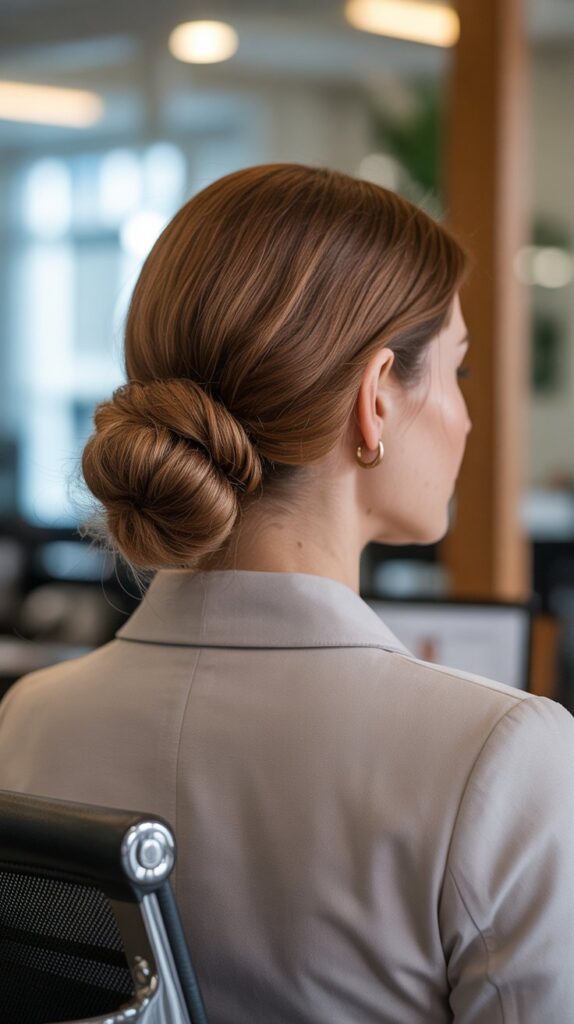
The low chignon is a sophisticated, understated hairstyle that epitomizes professional elegance while cleverly disguising greasy roots by incorporating them into a textured, deliberately styled updo.
This French-inspired style projects refinement without appearing overly formal or stuffy.
Creation Technique:
- Gather your hair into a low ponytail at the nape of your neck, securing it with a basic elastic band.
- Divide the ponytail into two or three sections depending on your hair thickness.
- Twist each section loosely, keeping the twists soft rather than tight for a more relaxed, textured appearance.
- Wrap the twisted sections around the base of the ponytail, layering them over each other to create depth.
- Tuck the ends underneath the chignon and secure everything with bobby pins inserted from multiple angles.
- Gently pull on sections of the chignon to loosen it slightly, creating an intentionally imperfect, effortless look.
- Leave a few wispy pieces around your face and neck for a softening effect that prevents the style from appearing too severe.
Professional Versatility:
This hairstyle adapts to any professional setting, from conservative law offices to creative marketing agencies, making it universally appropriate.
8. The Slicked-Back Style
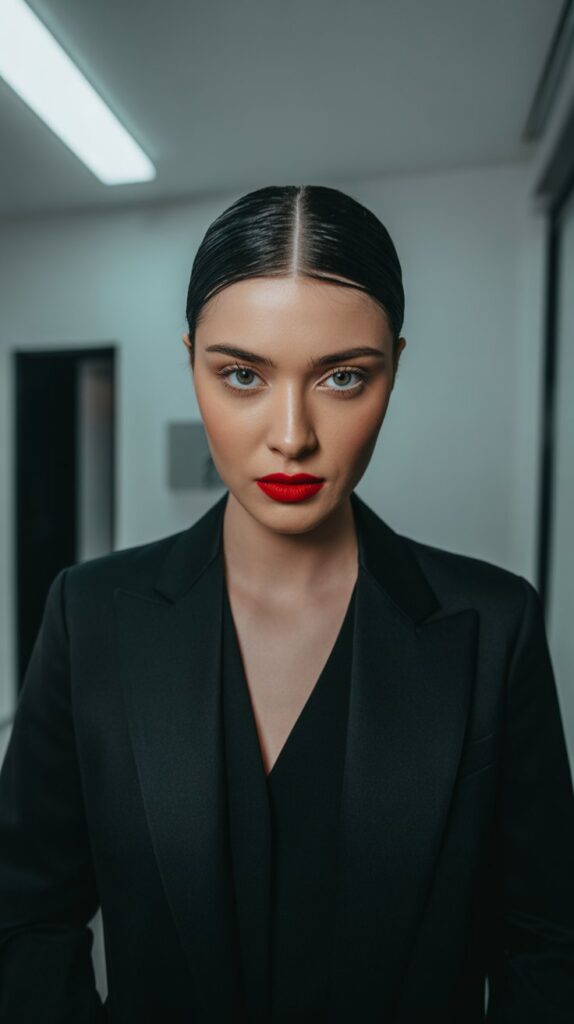
The slicked-back style embraces greasy hair completely, transforming what might seem like a styling challenge into a bold, intentional fashion statement that commands attention in professional settings.
This confident look works particularly well in creative industries and fashion-forward workplaces.
Styling Process:
- Apply a generous amount of styling gel or pomade to your hands, distributing it evenly across both palms.
- Work the product through your hair from roots to ends, ensuring complete coverage and saturation.
- Use a fine-toothed comb to slick all your hair straight back from your hairline toward the crown and beyond.
- Continue combing through the hair repeatedly to create a smooth, shiny surface without any bumps or texture breaks.
- For longer hair, either leave the length hanging down your back or gather it into a low ponytail at the nape.
- Apply additional gel to your hairline and around your ears to smooth down any resistant baby hairs or flyaways.
Confidence Factor:
This style requires confidence to pull off successfully, but it makes a powerful statement about self-assurance and fashion awareness in professional contexts.
9. The Messy Top Knot

The messy top knot strikes the perfect balance between professional polish and relaxed approachability, using greasy hair’s natural texture to create an effortlessly chic look that appears intentional rather than neglected.
This style has become increasingly acceptable in modern professional environments that value authenticity.
Assembly Instructions:
- Flip your head upside down and gather all your hair at the crown of your head using your fingers rather than a brush.
- Stand upright and twist the gathered hair loosely, keeping the twist relatively relaxed rather than tight.
- Wrap the twisted hair around itself in a circular motion, creating a bun shape at the top of your head.
- Secure the bun with a hair elastic, allowing some pieces to escape naturally rather than forcing everything into the knot.
- Gently pull on different sections of the bun to create a fuller, more voluminous appearance that looks deliberately undone.
- Allow a few face-framing pieces to fall loosely around your face, enhancing the intentionally imperfect aesthetic.
Modern Professionalism:
This hairstyle reflects current workplace trends toward authenticity and work-life balance while still maintaining appropriate grooming standards.
10. The Side Braid

The side braid offers a practical yet stylish solution for managing greasy hair at work, creating visual interest while keeping your hair controlled and professional throughout the day.
This style particularly benefits from hair’s natural oils, which help the braid maintain its structure and prevent flyaways.
Braiding Method:
- Create a deep side part, then sweep all your hair over one shoulder to position it for side braiding.
- Divide the hair into three equal sections at the point where you want the braid to begin, typically just below the ear.
- Begin a standard three-strand braid by crossing the right section over the middle, then the left section over the new middle.
- Continue braiding down the length of your hair, maintaining consistent tension to create an even, uniform braid.
- Secure the end with a small, professional-looking elastic that matches your hair color.
- Gently pull on the outer edges of the braid to widen it and create a fuller, more substantial appearance.
- Position the finished braid to drape over your shoulder in front, keeping it visible and preventing it from shifting around.
Practical Benefits:
This style keeps hair completely contained and under control during physical work activities while maintaining a polished, put-together appearance.
11. The Double Dutch Braids
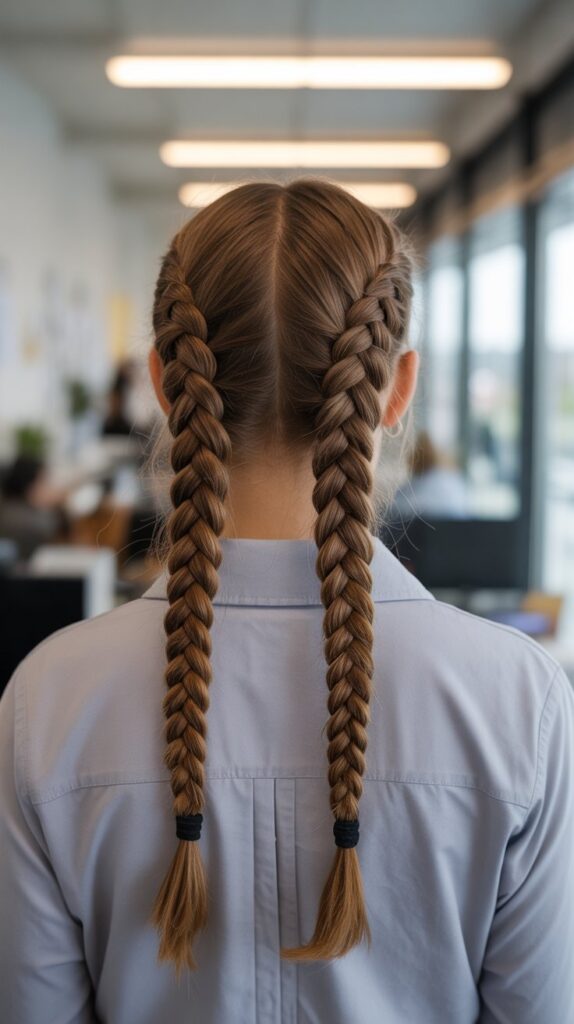
Double Dutch braids create an athletic yet professional look that has transcended gym culture to become acceptable in many modern workplaces, especially those with business-casual dress codes.
Greasy hair actually makes these braids easier to execute and helps them last longer without fraying.
Execution Process:
- Part your hair down the center from forehead to nape, creating two perfectly equal sections.
- Clip one section away while you work on the first braid to keep it separated.
- Begin the Dutch braid at your hairline by taking three small sections and crossing the outer strands under the middle strand rather than over.
- Add small amounts of hair to each section as you continue braiding down toward the nape, keeping the braid tight against your scalp.
- Continue braiding until you’ve incorporated all the hair on that side, then braid the remaining length normally and secure with an elastic.
- Repeat the entire process on the other side, ensuring both braids are positioned symmetrically and at equal heights.
- Gently tug on the edges of both braids to create width and make them appear fuller and more substantial.
Workplace Evolution:
As workplace dress codes have relaxed, styles like Dutch braids have gained acceptance as professional options that demonstrate personal style within appropriate boundaries.
12. The Wrapped Ponytail
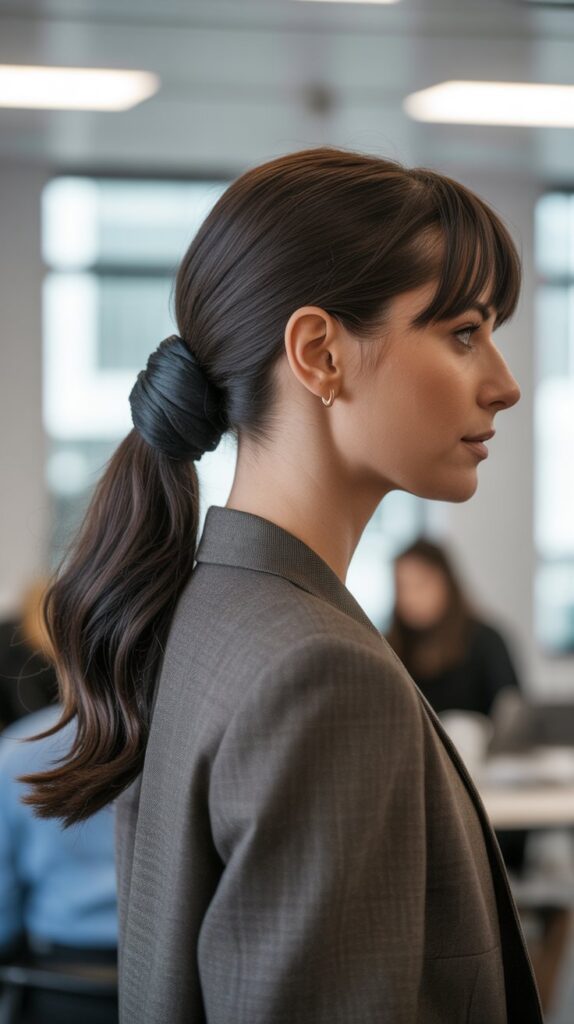
The wrapped ponytail elevates a basic ponytail into something more polished and intentional by using a section of hair to conceal the elastic band, creating a seamless, sophisticated look that disguises greasy roots.
This simple upgrade makes an enormous difference in overall appearance and professionalism.
Refinement Steps:
- Brush your hair into a ponytail at your desired height, whether high, medium, or low depending on your preference and workplace culture.
- Secure the ponytail tightly with a strong elastic band that matches your hair color as closely as possible.
- Separate a thin section of hair from the underside of the ponytail, approximately half an inch wide.
- Wrap this section around the elastic band, circling it multiple times until the elastic is completely hidden from view.
- Secure the wrapped section underneath the ponytail with a bobby pin, tucking it neatly so no pins are visible.
- Apply a small amount of hairspray or gel to the wrapped section to keep it smooth and prevent it from unwinding.
Professional Distinction:
This small detail elevates your entire look from casual to carefully groomed, demonstrating attention to detail that reflects well on your professional image.
13. The Vintage Victory Rolls
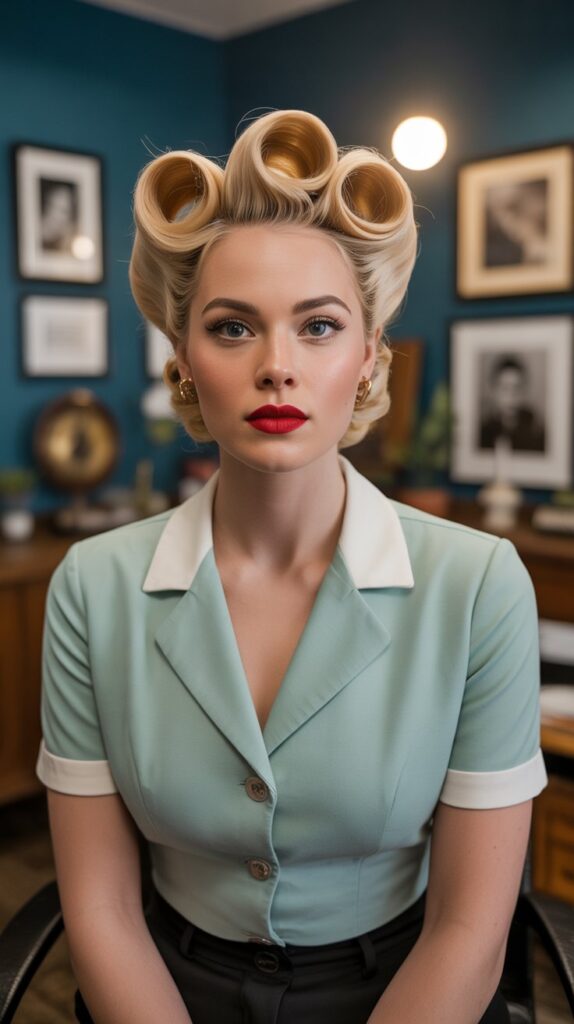
Victory rolls bring retro sophistication to the workplace, transforming greasy hair into a statement style that projects confidence, individuality, and attention to grooming detail.
While more dramatic than some professional styles, they work beautifully in creative industries and fashion-forward companies.
Vintage Styling:
- Section off the front portion of your hair from temple to temple, leaving the back section loose or pinned for later styling.
- Divide the front section into two equal parts, creating a center part that extends several inches back from your hairline.
- Take one front section and brush it upward and forward, creating volume at the root by backcombing slightly if needed.
- Roll the section backward toward your scalp, creating a tube or cylinder shape that stands up from your head.
- Pin the roll securely against your scalp using crossed bobby pins that penetrate through the roll into your hair underneath.
- Repeat the process on the other side, creating a matching roll that mirrors the first in size and position.
- Style the remaining hair at the back in a way that complements the rolls, such as curls, a bun, or left hanging down.
Era-Appropriate Professionalism:
While inspired by 1940s styling, modern interpretations of victory rolls maintain professional appropriateness while adding personality and flair.
14. The Rope Braid Ponytail
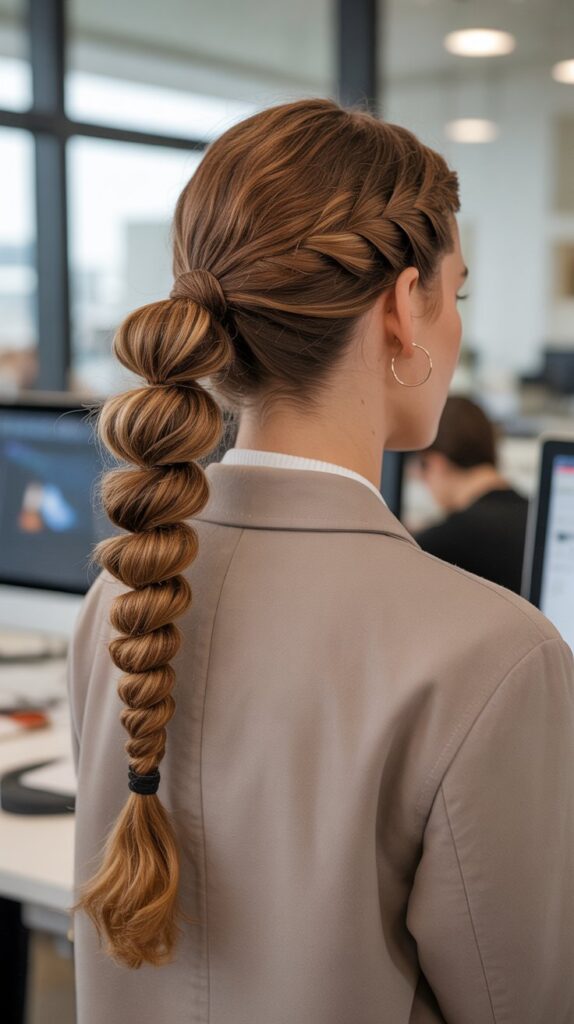
The rope braid ponytail combines the simplicity of a ponytail with the visual interest of braiding, creating a textured, professional look that benefits from greasy hair’s natural grip and hold.
This style appears more complex than it actually is, making it perfect for busy mornings when you need sophistication without time investment.
Rope Braid Construction:
- Pull your hair into a ponytail at your desired height and secure it firmly with an elastic band.
- Divide the ponytail into two equal sections, holding one in each hand.
- Twist the right section clockwise, continuing to twist tightly from base to end.
- Twist the left section clockwise in the same manner, ensuring both sections are twisted in the same direction.
- Wrap the two twisted sections around each other in a counterclockwise direction, creating a rope-like appearance.
- Continue wrapping until you reach the ends, then secure everything with another elastic band.
- Gently pull on the rope braid to widen it and create a fuller, more substantial look that appears deliberately styled.
Time Efficiency:
This style takes less time than traditional braiding while delivering equally impressive results, making it ideal for busy professionals.
15. The Low Side Bun
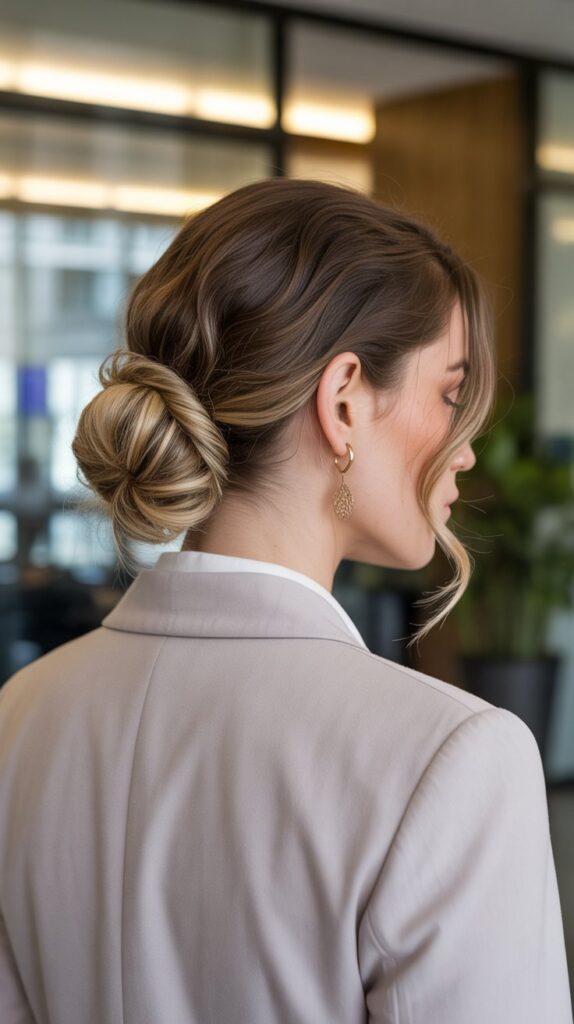
The low side bun offers an asymmetrical take on classic updo styling, positioning the bun at the side of the neck rather than the center back for a modern, fashion-forward appearance.
Greasy hair helps this bun maintain its shape and position without sliding or loosening throughout the workday.
Positioning Technique:
- Create a deep side part, then sweep all your hair to one side of your neck, positioning it just below and behind your ear.
- Gather the hair into a low ponytail at this side position and secure it with an elastic band.
- Twist the ponytail length loosely, keeping some texture rather than creating a tight, smooth twist.
- Wrap the twisted hair around the base of the ponytail in a circular motion, building up the bun at the side of your neck.
- Secure the bun with bobby pins inserted at multiple angles to ensure it stays in place during movement.
- Leave a few strategic pieces loose around your face to soften the overall look and prevent it from appearing too severe.
Modern Aesthetic:
The asymmetrical placement of this bun reflects current fashion trends while remaining appropriate for professional settings.
16. The Half-Up Braid

The half-up braid combines the professionalism of secured hair with the softness of wearing it down, creating a balanced look that works across various professional environments.
This style uses greasy hair’s texture to create a braid that holds its shape and adds dimension without appearing messy or unkempt.
Braiding Application:
- Section off the top half of your hair from temple to temple, gathering it at the crown of your head.
- Divide this top section into three equal parts to begin a standard three-strand braid.
- Braid this section for several inches, creating a short braid that will sit atop the loose hair below.
- Secure the end of the braid with a small, discreet elastic that matches your hair color.
- Allow the remaining hair to hang loose over your shoulders, creating contrast between the braided and unbraided sections.
- Gently pull on the edges of the braid to widen it and create visual interest and texture.
- Apply a small amount of smoothing serum to the loose hair to enhance shine and reduce any frizz.
Versatile Appropriateness:
This style adapts to both formal and casual professional settings by adjusting the tightness of the braid and the styling of the loose hair.
17. The Twisted Low Bun

The twisted low bun creates an elegant, textured updo that transforms greasy hair into an asset rather than a liability, using the natural oils to enhance the twisted sections and create a deliberately sophisticated appearance.
This style projects professionalism while remaining comfortable enough for all-day wear.
Twist and Secure Method:
- Gather all your hair at the nape of your neck into a low ponytail position without actually securing it with an elastic.
- Divide the gathered hair into two equal sections, holding one in each hand.
- Twist each section individually in the same direction, creating two separate twisted rope-like pieces.
- Wrap the two twisted sections around each other, creating a twisted bun at the nape of your neck.
- Tuck any loose ends underneath the bun and secure everything with bobby pins inserted from various angles.
- Gently pull on sections of the bun to loosen it slightly and create a softer, more romantic appearance.
- Apply a light mist of hairspray to set the style and prevent any pieces from slipping out during the day.
Textural Interest:
The twisting technique creates natural dimension and visual interest that elevates this style above a standard smooth bun.
18. The Braided Headband Style
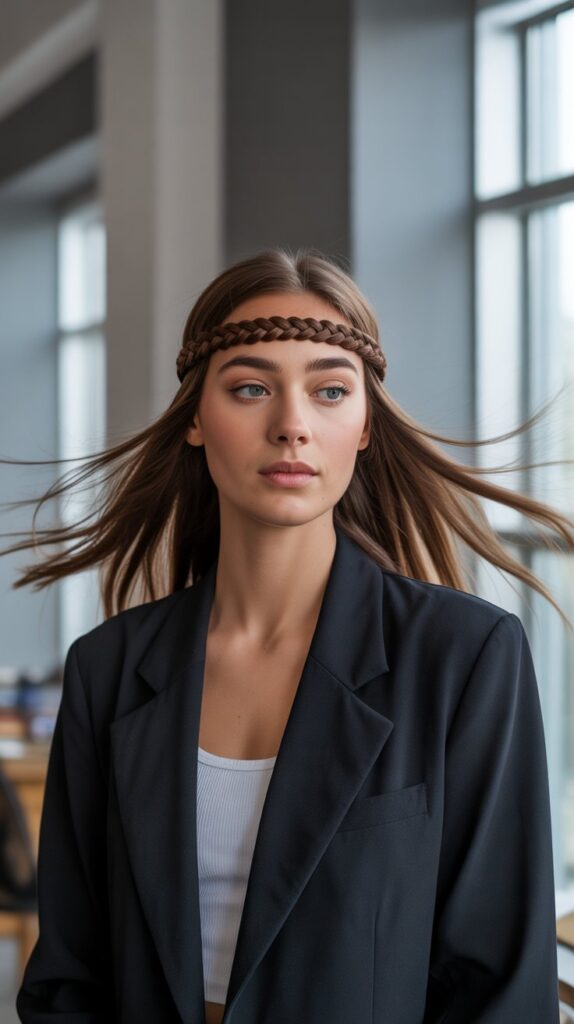
The braided headband style uses your own hair to create a headband effect across your hairline, keeping face-framing hair secured while allowing the rest to flow freely down your back.
Greasy hair makes this braid stay in place better than freshly washed hair, which can be too slippery to maintain the headband position.
Headband Creation:
- Take a section of hair from behind one ear, approximately one to two inches wide depending on desired headband thickness.
- Braid this section in a standard three-strand braid, keeping it relatively tight to maintain its structure as a headband.
- Bring the braid across the top of your head, positioning it like a headband from ear to ear.
- Secure the end of the braid behind your opposite ear with bobby pins, tucking them underneath to hide them from view.
- Leave the remaining hair down, allowing it to flow naturally over your shoulders.
- Adjust the position of the braided headband to ensure it sits comfortably and securely across your hairline.
- Pin the braid in several places along its length to prevent it from shifting or sliding back during the day.
Bohemian Professionalism:
This style adds a touch of bohemian flair to professional attire while maintaining appropriate grooming standards for the workplace.
19. The Bubble Ponytail
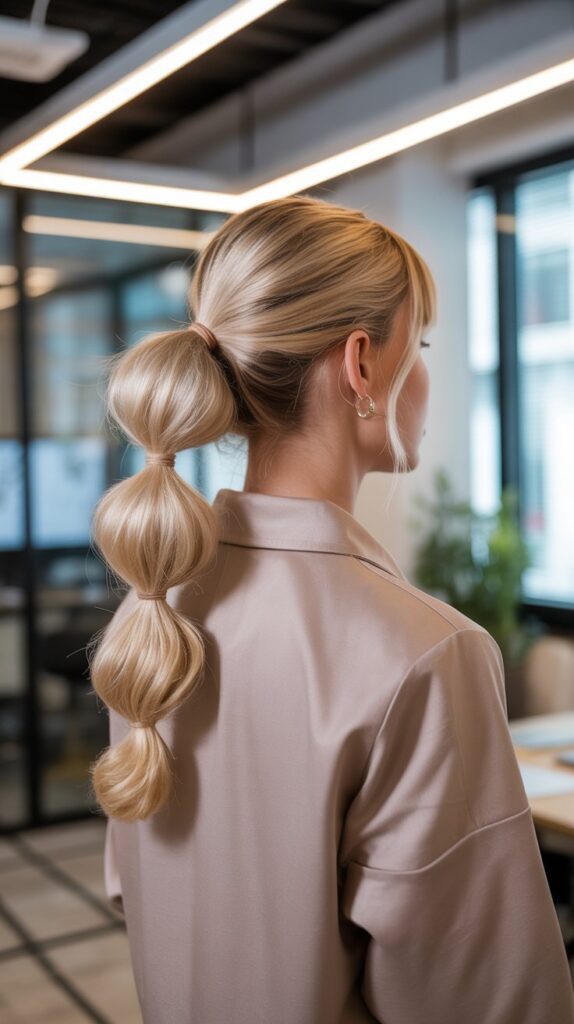
The bubble ponytail adds dimension and visual interest to a basic ponytail by creating segmented “bubbles” down its length, transforming greasy hair into a deliberately styled, trendy look appropriate for modern professional environments.
This style has gained popularity as workplace dress codes have evolved to embrace more creative expression.
Bubble Segmentation:
- Pull your hair into a ponytail at your desired height and secure it with a strong elastic band.
- Measure down approximately three to four inches from the first elastic and add another elastic band around the ponytail.
- Gently pull on the hair between the two elastics, pushing it outward to create a rounded bubble shape.
- Continue adding elastic bands every few inches down the length of the ponytail, creating multiple segments.
- Puff out each section between elastics to create uniform bubbles that are consistent in size and shape.
- Ensure all elastic bands are tight enough to maintain the bubble structure throughout your workday.
- Leave the final section at the end unbanded, or secure it if you prefer a finished look without loose ends.
Contemporary Appeal:
This playful yet polished style demonstrates fashion awareness and personal style while remaining professional and workplace-appropriate.
20. The Faux Hawk Updo
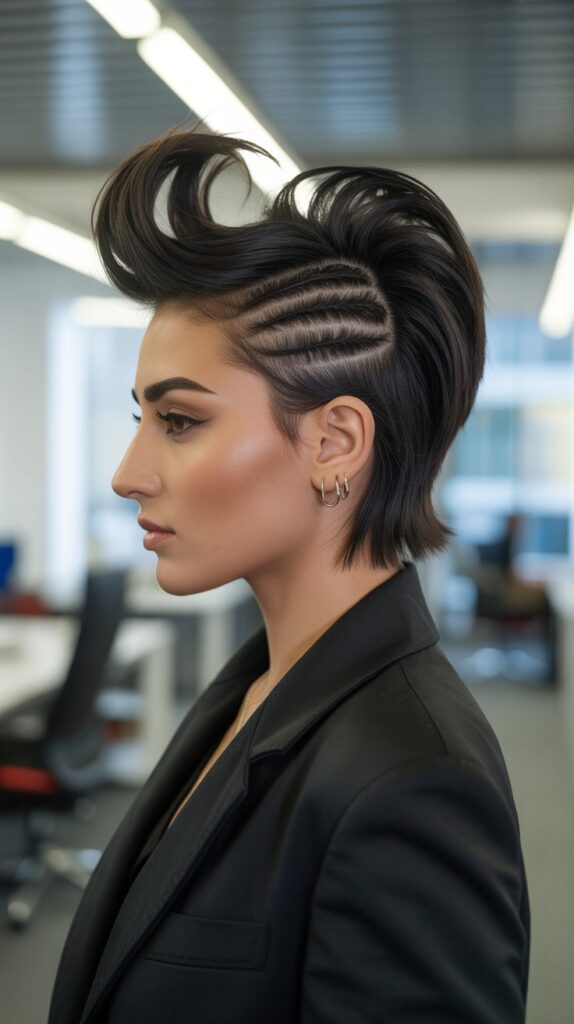
The faux hawk updo brings edge and personality to professional styling, creating a bold statement that uses greasy hair’s texture to build height and structure along the center of the head.
This style works particularly well in creative industries where individuality and self-expression are valued alongside professionalism.
Structural Building:
- Section your hair down the center from front to back, creating a mohawk-shaped strip approximately three inches wide.
- Clip the side sections away temporarily, keeping them separated from the center section you’ll be working with.
- Backcomb the center section aggressively to create volume and texture that will support the faux hawk structure.
- Smooth the top layer of the backcombed section with a brush, creating a polished exterior while maintaining the volume underneath.
- Pin the center section upward and forward, creating height along the center line of your head from front to back.
- Smooth the side sections back toward the center, pinning them underneath the raised center section to create clean sides.
- Secure everything with numerous bobby pins to ensure the structure holds throughout the day despite movement.
Industry Appropriateness:
While bold, this style has found acceptance in fashion, media, entertainment, and other creative professional sectors that value distinctive personal style.
21. The Pulled-Through Braid

The pulled-through braid creates the illusion of an intricate braid without actually requiring traditional braiding skills, making it perfect for professionals who want sophisticated styling without extensive hair expertise.
Greasy hair helps each section maintain its shape and prevents the style from falling flat or losing definition.
Pull-Through Technique:
- Create a high ponytail at the crown of your head and secure it with an elastic band.
- Take a small section from the top of the ponytail and secure it with another elastic about two inches down from the first.
- Divide the remaining hair below this second elastic into two sections, pulling them forward on either side of the secured section.
- Take another section of hair from behind and pull it through the middle, securing it with an elastic two inches down.
- Continue this pull-through process, always bringing the side sections forward and pulling a new section through the middle.
- After completing all sections, gently pull on the edges of each segment to widen them and create a fuller, more voluminous appearance.
- The final result resembles an intricate braid but requires no actual braiding skills to achieve.
Impressive Simplicity:
This style looks far more complicated than it actually is, allowing you to achieve an impressive look with minimal time and skill investment.
22. The Pinned-Back Sides

The pinned-back sides style offers a simple yet effective solution for managing greasy hair around your face while leaving the rest of your hair down, creating a professional appearance that maintains personality and style.
This approach works beautifully for professionals who prefer wearing their hair down but need to keep it out of their face during work.
Strategic Pinning:
- Take a section of hair from one side of your head, starting at your temple and extending back to just above your ear.
- Twist this section slightly as you bring it back toward the center of your head, creating a soft rope-like shape.
- Secure the section at the back of your head with bobby pins, positioning them horizontally for maximum hold.
- Repeat the process on the other side, taking a matching section and pinning it back to meet the first section.
- Cross the pins at the meeting point to create extra security and prevent the sections from slipping out.
- Leave the remaining hair flowing down your back, creating contrast between the secured and loose sections.
- Apply a small amount of texturizing spray to the loose hair for added dimension and movement.
Minimal Effort Maximum Impact:
This style requires only a few pins and a minute or two of styling time while delivering a polished, professional appearance.
23. The Low Ponytail with Center Part
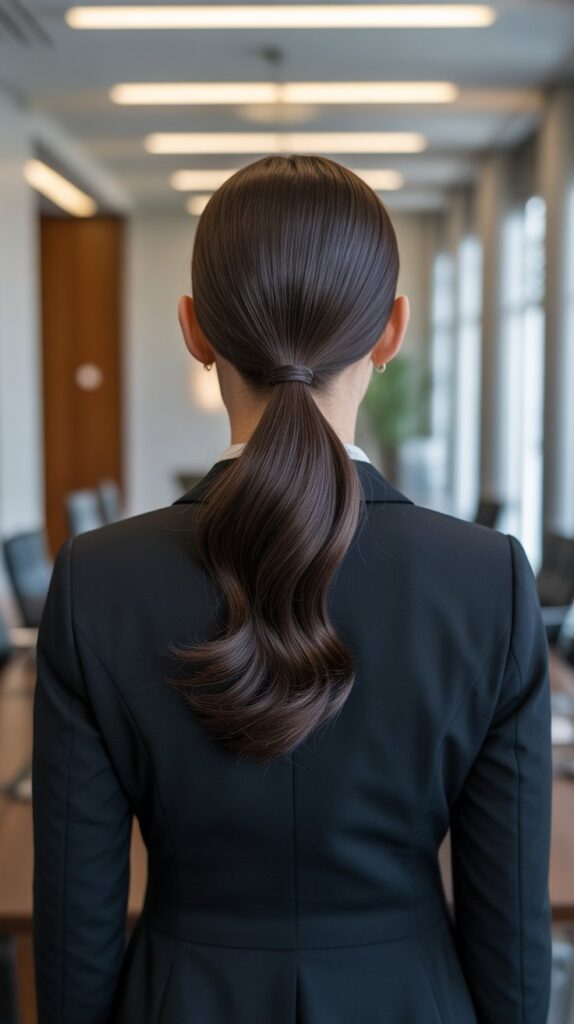
The low ponytail with center part creates a sleek, symmetrical look that projects professionalism and attention to detail while using greasy hair’s natural smoothness to achieve a polished finish.
This classic style never goes out of fashion in professional environments and adapts to virtually any workplace dress code.
Symmetrical Styling:
- Create a precise center part using a tail comb, extending it from your forehead all the way back to your crown.
- Brush each side of the part smooth, working the natural oils through your hair to enhance shine and control.
- Gather all your hair at the nape of your neck, positioning the ponytail in the exact center of your head.
- Secure the ponytail with an elastic band, ensuring both sides of the part remain perfectly symmetrical and smooth.
- Apply gel or smoothing cream to your hairline and part to eliminate any flyaways or frizz.
- Take a small section of hair from the ponytail and wrap it around the elastic to conceal it and add polish.
- Finish with a light application of shine spray to enhance the sleek, professional appearance of the style.
Classic Reliability:
This timeless style works for any professional occasion, from job interviews to board meetings, making it a reliable choice when professional appearance is paramount.
24. The Knotted Bun
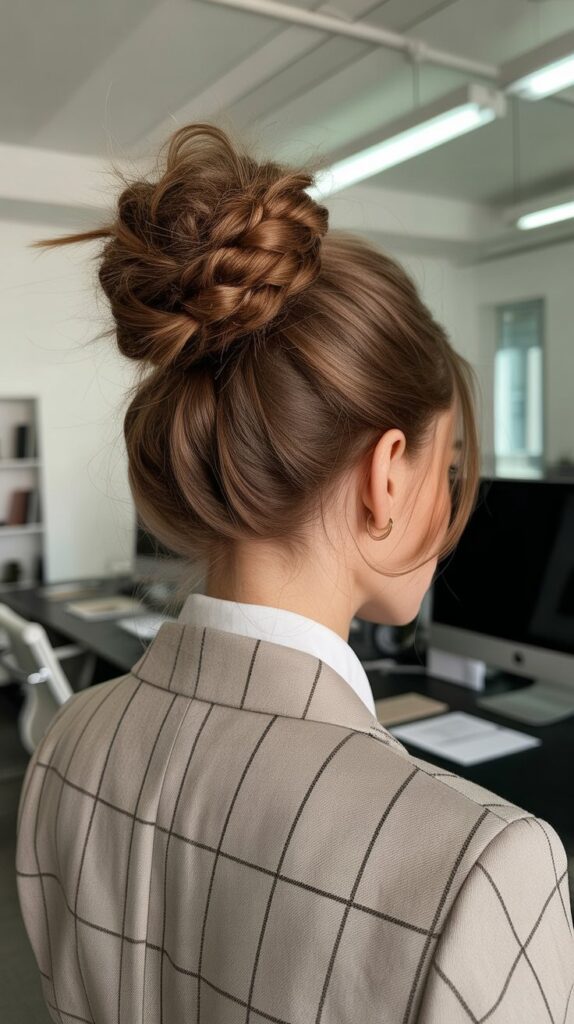
The knotted bun creates an architectural, artistic updo that transforms greasy hair into a deliberately styled statement piece suitable for fashion-forward professional environments.
This style demonstrates sophistication and style awareness while maintaining the polish necessary for workplace appropriateness.
Knot Formation:
- Gather your hair into a high ponytail at the crown of your head and secure it with an elastic band.
- Divide the ponytail into two equal sections, holding one in each hand.
- Tie these two sections together in a simple overhand knot, just like you would tie a shoe lace.
- Continue tying knots down the length of the ponytail, creating multiple knots stacked on top of each other.
- Wrap the knotted length around the base of the ponytail, creating a bun shape made entirely of knots.
- Tuck any remaining ends underneath the bun and secure everything with bobby pins from multiple directions.
- Gently pull on the knots to loosen them slightly and create a fuller, more voluminous bun with visible texture.
Artistic Professionalism:
This style bridges the gap between artistic expression and workplace appropriateness, making it ideal for creative professionals who want to showcase their style sensibility.
25. The Twisted Side Updo

The twisted side updo combines asymmetry with elegance, sweeping all hair to one side and securing it in twisted sections that create depth and dimension.
Greasy hair’s natural texture makes the twists more defined and easier to manipulate into this sophisticated style that works beautifully for important meetings and presentations.
Asymmetrical Assembly:
- Create a deep side part, positioning it far to one side of your head rather than near the center.
- Sweep all your hair over to the opposite side, gathering it behind one ear at the side of your neck.
- Divide the gathered hair into multiple small sections, approximately four to six depending on your hair thickness.
- Twist each section individually, creating rope-like pieces that spiral from root to end.
- Pin each twisted section against your head, arranging them in an artistic cluster behind your ear.
- Layer the twists over each other to create depth and dimension, securing each one with multiple bobby pins.
- Tuck all ends underneath the twisted sections, creating a seamless finish without visible loose pieces.
Sophisticated Asymmetry:
The side placement of this updo creates visual interest while maintaining the refinement necessary for professional settings.
26. The Double Twisted Bun
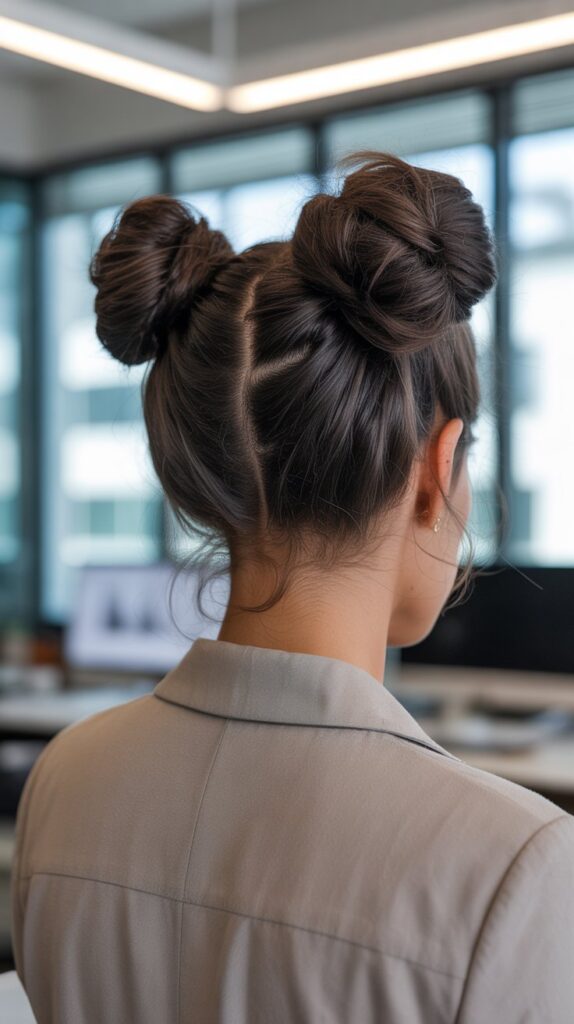
The double twisted bun offers a unique take on traditional bun styling by creating two separate twisted buns positioned side by side, resulting in a playful yet professional look.
This style uses greasy hair’s weight and texture to keep both buns secure and well-defined throughout lengthy workdays.
Dual Bun Construction:
- Part your hair down the center from forehead to nape, creating two perfectly equal sections.
- Gather one section into a ponytail positioned slightly off-center, about two inches from the center part.
- Twist this ponytail length tightly, then wrap it around its base to create a compact bun on one side.
- Secure the first bun thoroughly with bobby pins, ensuring it’s stable before moving to the second side.
- Repeat the process on the other section, creating a matching bun positioned symmetrically to the first.
- Ensure both buns are at the same height and similar in size for a balanced, intentional appearance.
- Apply smoothing serum to any flyaways and finish with hairspray to maintain the style’s structure.
Modern Professional Expression:
While unconventional, this style has gained acceptance in contemporary workplaces that value individuality and creative self-expression within professional boundaries.
27. The Rolled Chignon
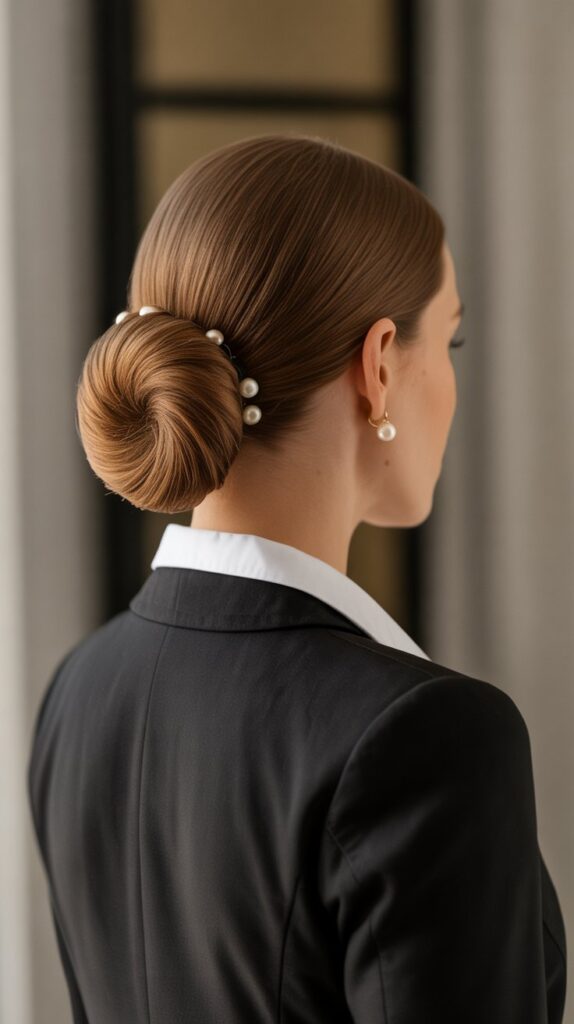
The rolled chignon represents the pinnacle of professional elegance, creating a sophisticated updo that rolls the hair into a structured shape at the nape of the neck.
This classic style benefits significantly from greasy hair, which provides the necessary grip and weight to keep the roll secure and maintain its shape throughout demanding workdays.
Roll and Secure Process:
- Brush all your hair down and back, gathering it at the nape of your neck without creating a ponytail.
- Hold the gathered hair with one hand while using your other hand to tuck the ends underneath, creating a roll.
- Continue rolling the hair upward toward your head, keeping the roll tight and compact as you work.
- Once you’ve rolled the hair to the desired height at the nape of your neck, secure it with bobby pins inserted vertically.
- Add additional horizontal pins across the top and bottom of the roll for extra security and stability.
- Smooth any bumps or irregularities on the surface using your hands or a brush with additional smoothing product.
- Tuck any loose ends or wispy pieces into the roll, creating a seamless, polished finish.
Timeless Elegance:
This sophisticated style has remained a professional staple for decades because it projects competence, attention to detail, and respect for professional grooming standards.
Essential Products for Styling Greasy Hair Professionally
Understanding which products work best with greasy hair can enhance your styling results and extend the professional appearance of your chosen hairstyle throughout the workday.
Dry Shampoo Application:
- Spray dry shampoo at the roots in sections, focusing on the areas where oil accumulates most heavily like the hairline and crown.
- Allow the product to sit for two to three minutes so it can absorb the excess oil effectively before styling.
- Massage the product into your scalp with your fingertips to distribute it evenly and prevent white residue.
- Brush through thoroughly to remove any visible powder while maintaining the oil-absorbing benefits.
Styling Gel and Pomade:
- These products work synergistically with greasy hair rather than fighting against it, enhancing shine and control.
- Apply to damp or oily hair for maximum hold and sleekness in styles like the slicked-back or French twist.
- Use sparingly to avoid creating a heavy, weighed-down appearance that looks overly greasy rather than styled.
Texturizing Products:
- Texturizing spray adds grip to greasy hair, making braids and twisted styles easier to create and maintain.
- These products enhance the natural texture that oily hair provides without requiring a fresh wash.
- Apply to the lengths and ends rather than the roots to avoid adding more oil to already greasy areas.
Bobby Pins and Elastics:
- Invest in high-quality bobby pins that grip effectively and don’t slip out of oily hair throughout the day.
- Use elastics with no metal parts to prevent hair breakage and ensure they’re tight enough to hold greasy hair securely.
- Keep extras in your desk drawer or bag for touch-ups during long workdays when styles may need reinforcement.
For more information on professional hair care and styling products, visit reputable beauty retailers and consult with hair care professionals at Sephora or Ulta Beauty.
Tips for Maintaining Professional Hairstyles Throughout the Workday
Even the most carefully crafted hairstyle requires maintenance and touch-ups during lengthy workdays, especially when working with greasy hair that may continue to produce oil as the day progresses.
Morning Preparation:
- Set aside sufficient time in your morning routine to properly execute your chosen hairstyle rather than rushing through it.
- Use adequate pins, elastics, and product to ensure your style is secure from the start, preventing the need for extensive midday repairs.
- Check your hairstyle from all angles using a hand mirror to catch any issues before leaving home.
Midday Touch-Ups:
- Keep a small emergency kit in your desk with bobby pins, elastics, dry shampoo, and a small brush or comb.
- Visit the restroom during lunch or breaks to check your hairstyle and make any necessary adjustments before afternoon meetings.
- Reapply dry shampoo at the roots if additional oil has accumulated since morning, refreshing your style’s appearance.
End-of-Day Considerations:
- If you have after-work events or networking opportunities, plan your hairstyle accordingly to ensure it lasts through extended wear.
- Consider styles with built-in longevity like buns and braids that actually improve as they settle throughout the day.
- Bring a small travel-size hairspray for evening touch-ups if you’re transitioning directly from work to social or professional events.
Environmental Factors:
- Adjust your styling approach based on weather conditions, using more product in humid environments where hair may become greasier faster.
- In air-conditioned offices, hair may actually dry out somewhat as the day progresses, requiring less touch-up than anticipated.
- Consider how physical activity during your workday might affect your hairstyle and choose accordingly for active versus sedentary days.
Adapting Styles for Different Professional Environments
Different workplaces have varying expectations regarding professional appearance, and understanding these nuances helps you select the most appropriate greasy hair hairstyle for your specific environment.
Corporate and Financial Sectors:
- These conservative environments typically favor traditional, polished styles like the French twist, sleek low bun, or center-parted low ponytail.
- Avoid overly trendy or attention-grabbing styles that might be perceived as unprofessional or distracting from your work.
- Maintain pristine grooming with no visible flyaways or loose pieces that might appear unkempt or unfinished.
Creative Industries:
- Media, advertising, fashion, and design fields welcome more expressive hairstyles like the faux hawk updo, victory rolls, or bubble ponytail.
- These environments value individuality and style expression as reflections of creative thinking and cultural awareness.
- Experiment with bolder styles while still maintaining the polish and intentionality that distinguishes styled hair from neglected hair.
Healthcare and Education:
- These fields require practical, secure hairstyles that won’t interfere with patient care or classroom activities, favoring styles like braids and buns.
- Hair must be completely controlled and unable to fall forward into the face during physical tasks or when working closely with others.
- Choose styles that can withstand movement and activity while maintaining their professional appearance throughout long shifts.
Technology and Startups:
- These modern workplaces typically embrace casual professionalism, accepting a wide range of hairstyles from messy top knots to double Dutch braids.
- The focus is less on traditional grooming standards and more on competence, making personal style choices more flexible.
- Balance individual expression with the understanding that client meetings and presentations may still require more polished styling approaches.
For industry-specific professional development guidance, resources like LinkedIn Learning offer courses on professional image and workplace culture.
Understanding Hair Health While Working with Greasy Hair
While these professional hairstyles help you manage and style greasy hair effectively, understanding the underlying causes of oil production and maintaining scalp health remains important for long-term hair wellness.
Causes of Excess Oil Production:
- Hormonal fluctuations can increase sebum production, making hair appear greasier more quickly than usual during certain life phases.
- Overwashing hair can paradoxically cause increased oil production as your scalp compensates for stripped natural oils.
- Product buildup from styling products, dry shampoo, and other treatments can accumulate on the scalp and appear as greasiness.
- Touching your hair frequently throughout the day transfers oils from your hands to your hair, accelerating the greasy appearance.
Healthy Scalp Maintenance:
- Find your optimal washing schedule, which may be less frequent than daily washing for many people, allowing natural oils to balance.
- Use a clarifying shampoo weekly or biweekly to remove product buildup that can make hair appear greasier than it actually is.
- Massage your scalp regularly to promote healthy circulation and proper distribution of natural oils from roots to ends.
- Consider your diet and hydration, as internal health directly impacts skin and scalp oil production levels.
When to Seek Professional Help:
- If your hair becomes greasy within hours of washing despite proper hair care practices, consult a dermatologist about underlying scalp conditions.
- Sudden changes in oil production may indicate hormonal imbalances or other health issues worth investigating with healthcare professionals.
- Professional hairstylists can assess your specific hair type and recommend customized care routines to manage oil production effectively.
Balancing Style and Health:
- While these professional styles help manage greasy hair appearance, ensure you’re still washing regularly enough to maintain scalp hygiene and health.
- Avoid using excessive heat styling on greasy hair, as this can damage hair structure and potentially worsen long-term oil production.
- Give your hair regular breaks from tight styles that pull on the scalp, which can stress hair follicles and affect their health over time.
For evidence-based information about hair and scalp health, the American Academy of Dermatology provides comprehensive resources and guidance.
Conclusion
Managing greasy hair in professional settings no longer requires panic or last-minute hat solutions, as demonstrated throughout this comprehensive guide to 27 Professional Greasy Hair Hairstyles for Work.
Each style presented here proves that oily hair can be transformed into a styling advantage rather than a grooming obstacle, with the natural oils providing texture, hold, and sleekness that freshly washed hair often lacks.
From classic updos that project traditional professionalism to modern twisted styles that reflect contemporary workplace culture, these hairstyles span the full spectrum of professional environments and personal preferences.
The key to success lies in embracing your hair’s natural state while applying simple techniques that transform greasy hair into intentionally styled, polished looks appropriate for any workplace setting.
By mastering even a handful of these styles, you’ll never again feel unprepared or unprofessional due to unwashed hair, instead walking into work with confidence knowing you look put-together and ready to tackle whatever your professional day demands.
Remember that professional appearance extends beyond just clean hair to encompass creativity, resourcefulness, and the ability to present yourself well under any circumstances—qualities these hairstyles help you demonstrate every single day.
